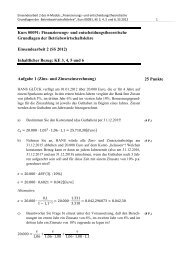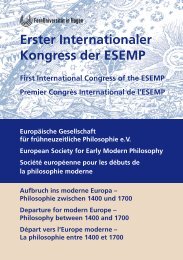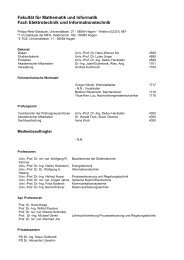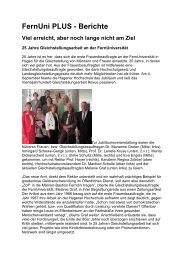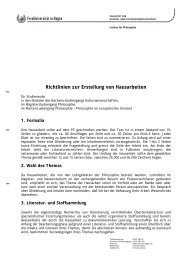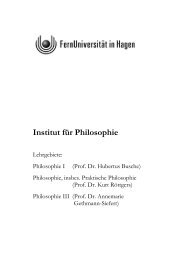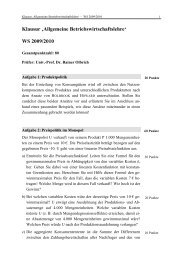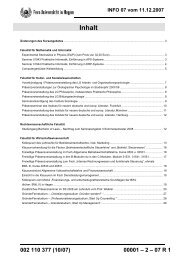An Invitation to Random Schr¨odinger operators - FernUniversität in ...
An Invitation to Random Schr¨odinger operators - FernUniversität in ...
An Invitation to Random Schr¨odinger operators - FernUniversität in ...
Create successful ePaper yourself
Turn your PDF publications into a flip-book with our unique Google optimized e-Paper software.
18<br />
〈ϕ, µ(M)ψ〉 = µ ϕ,ψ (M) (3.40)<br />
The functional calculus can be implemented for unbounded self adjo<strong>in</strong>t opera<strong>to</strong>rs<br />
as well. For such opera<strong>to</strong>rs the spectrum is always a closed set. It is compact only<br />
for bounded opera<strong>to</strong>rs.<br />
We will use the functional calculus virtually everywhere throughout this paper. For<br />
example, it gives mean<strong>in</strong>g <strong>to</strong> the opera<strong>to</strong>r e −itH used <strong>in</strong> (2.4). We will look at the<br />
projection valued measures χ M (A) more closely <strong>in</strong> chapter 7.<br />
3.3. Some more functional analysis.<br />
In this section we recall a few results from functional analysis and spectral theory<br />
and establish notations at the same time. In particular, we discuss the m<strong>in</strong>-max<br />
pr<strong>in</strong>ciple and the S<strong>to</strong>ne-Weierstraß theorem.<br />
Let A be a selfadjo<strong>in</strong>t (not necessarily bounded) opera<strong>to</strong>r on the (separable) Hilbert<br />
space H with doma<strong>in</strong> D(A). We denote the set of eigenvalues of A by ε(A). Obviously,<br />
any eigenvalue of A belongs <strong>to</strong> the spectrum σ(A). The multiplicity of an<br />
eigenvalue λ of A is the dimension of the eigenspace {ϕ ∈ D(A); Aϕ = λϕ}<br />
associated <strong>to</strong> λ. If µ is the projection valued spectral measure of A, then the<br />
multiplicity of λ equals tr µ({λ}). <strong>An</strong> eigenvalue is called simple or non degenerate<br />
if its multiplicity is one, it is called f<strong>in</strong>itely degenerate if its eigenspace<br />
is f<strong>in</strong>ite dimensional. <strong>An</strong> eigenvalue λ is called isolated if there is an ε > 0<br />
such that σ(A) ∩ (λ − ε, λ + ε) = {λ}. <strong>An</strong>y isolated po<strong>in</strong>t <strong>in</strong> the spectrum<br />
is always an eigenvalue. The discrete spectrum σ dis (A) is the set of all isolated<br />
eigenvalues of f<strong>in</strong>ite multiplicity. The essential spectrum σ ess (A) is def<strong>in</strong>ed by<br />
σ ess (A) = σ(A) \ σ dis (A).<br />
The opera<strong>to</strong>r A is called positive if 〈φ, Aφ〉 ≥ 0 for all φ <strong>in</strong> the doma<strong>in</strong> D(A), A<br />
is called bounded below if 〈φ, Aφ〉 ≥ −M〈φ, φ〉 for some M and all φ ∈ D(A).<br />
We def<strong>in</strong>e<br />
µ 0 (A) = <strong>in</strong>f {〈φ, Aφ〉 ; φ ∈ D(A), ‖φ‖ = 1} (3.41)<br />
and for k ≥ 1<br />
µ k (A) = sup<br />
ψ 1 ,...,ψ k ∈H<br />
<strong>in</strong>f {〈φ, Aφ〉 ; φ ∈ D(A), ‖φ‖ = 1, φ ⊥ ψ 1 , . . . , ψ k }<br />
(3.42)<br />
The opera<strong>to</strong>r A is bounded below iff µ 0 (A) > −∞ and µ 0 (A) is the <strong>in</strong>fimum of<br />
the spectrum of A.<br />
If A is bounded below and has purely discrete spectrum (i.e. σ ess (A) = ∅), we can<br />
order the eigenvalues of A <strong>in</strong> <strong>in</strong>creas<strong>in</strong>g order and repeat them accord<strong>in</strong>g <strong>to</strong> their<br />
multiplicity, namely<br />
E 0 (A) ≤ E 1 (A) ≤ E 2 (A) ≤ . . . . (3.43)<br />
If an eigenvalue E of A has multiplicity m it occurs <strong>in</strong> (3.43) exactly m times.<br />
The m<strong>in</strong>-max pr<strong>in</strong>ciple relates the E k (A) with the µ k (A).




